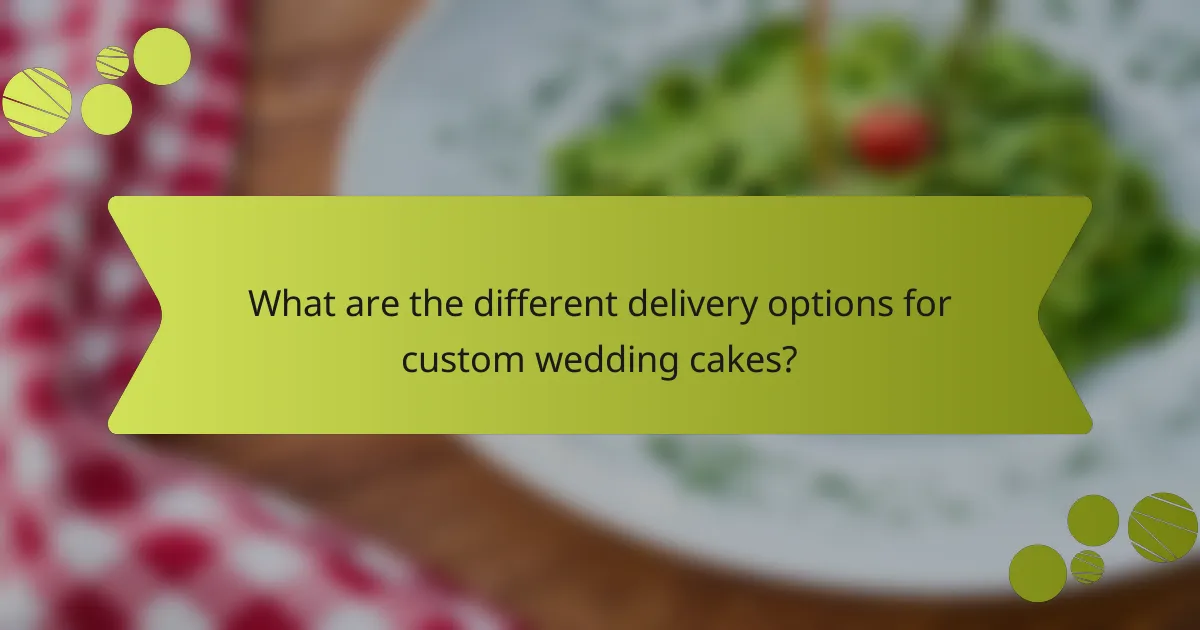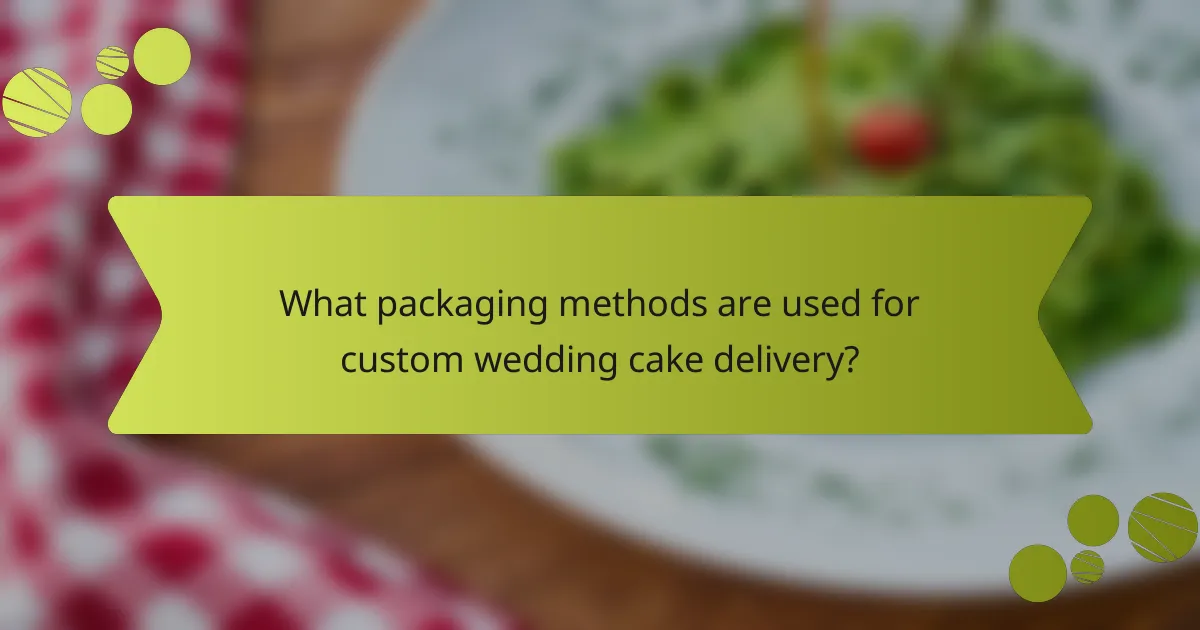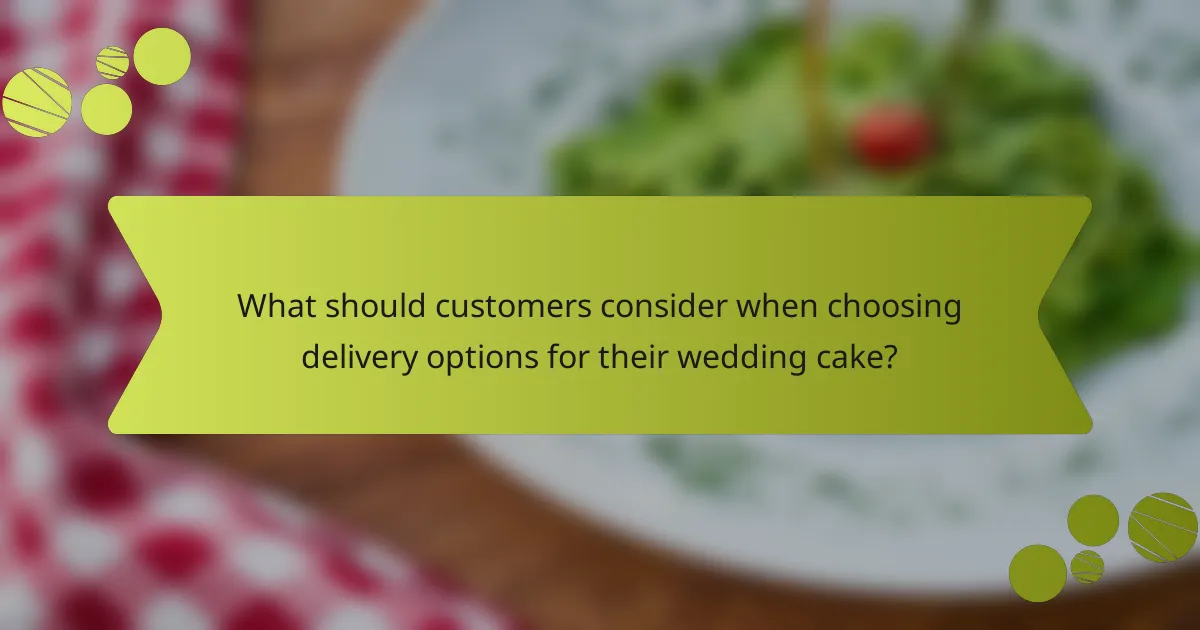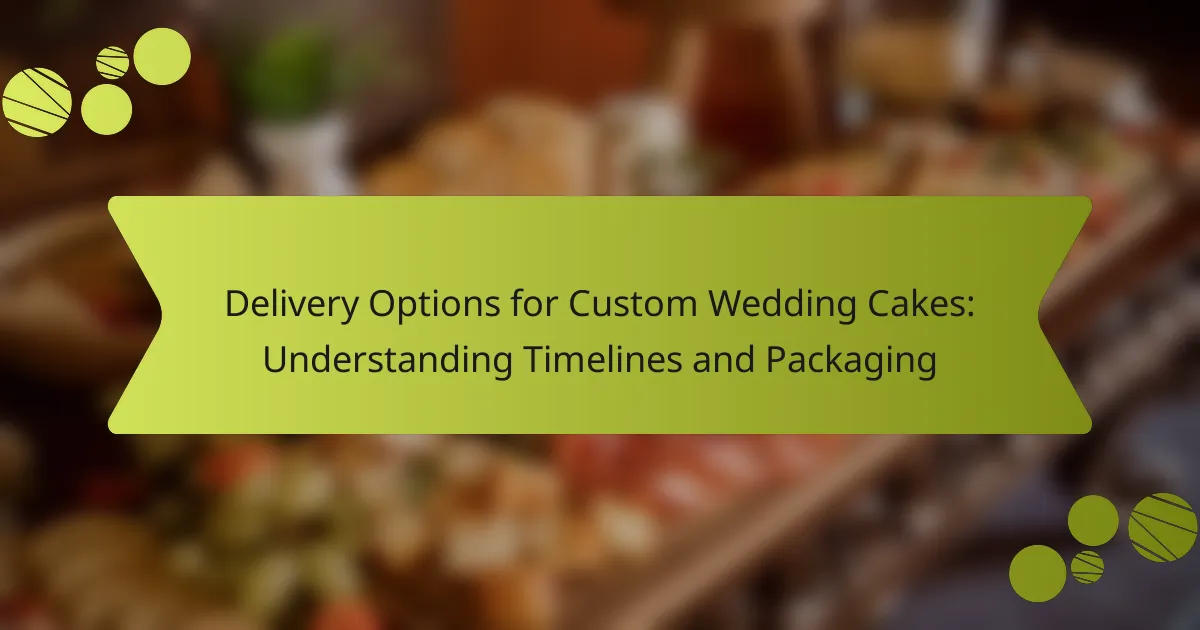Custom wedding cake delivery involves several options, including in-person delivery by the bakery, third-party delivery services, and client pick-up. Each delivery method varies in cost, reliability, and suitability based on the cake’s size and complexity. Proper packaging techniques, such as sturdy cake boxes and adjustable carriers, are essential to protect the cake during transport and maintain its presentation. Factors such as the cake’s design, fragility, distance to the venue, and timing of delivery are crucial considerations for customers when selecting the best delivery option. Bakeries often provide guidance to ensure that the cake arrives safely and fresh for the event.

What are the different delivery options for custom wedding cakes?
Custom wedding cakes can be delivered through several options. The primary delivery methods include in-person delivery by the bakery, third-party delivery services, and pick-up by the client. In-person delivery ensures the cake arrives safely and is often included in the service by many bakeries. Third-party delivery services can be utilized for added convenience, especially for longer distances. Client pick-up allows couples to collect their cake directly, which can be beneficial for local orders. Each option varies in terms of cost, reliability, and time management. Bakeries typically provide detailed information on the best choice based on the cake’s size and complexity.
How do delivery options vary based on cake design?
Delivery options vary based on cake design due to factors like size, structure, and decoration. Intricate designs require more careful handling and specialized packaging. Cakes with multiple tiers may need to be delivered separately and assembled on-site. The use of delicate decorations can limit transportation methods. For example, a simple round cake can be transported in standard boxes. However, a sculpted cake may require climate-controlled vehicles to maintain its integrity. Delivery timelines also adjust according to the complexity of the design. More elaborate cakes typically necessitate longer preparation times to ensure quality upon arrival.
What factors influence the choice of delivery method?
Factors influencing the choice of delivery method include cake size, distance to the venue, and delivery time. Larger cakes require more careful handling and may need specialized transportation. Distance affects the risk of damage during transit, as longer journeys increase the likelihood of temperature fluctuations and bumps. The delivery time is crucial; cakes need to arrive fresh and in optimal condition. Additionally, weather conditions can impact delivery choices, as extreme temperatures may necessitate refrigerated transport. Lastly, budget considerations can limit options, as some delivery methods may be more expensive than others.
How does the size of the cake affect delivery logistics?
The size of the cake significantly impacts delivery logistics. Larger cakes require more space and specialized packaging to prevent damage. They may also necessitate a larger vehicle for transportation. Additionally, bigger cakes can increase delivery time due to careful handling. Routes may need to be adjusted to accommodate the weight and size. For instance, a three-tier cake weighs more than a single-layer cake. This added weight can affect fuel consumption and delivery costs. Overall, cake size directly influences logistical planning for safe and timely delivery.
What are the typical timelines for delivering custom wedding cakes?
Typical timelines for delivering custom wedding cakes range from one week to several months. Most bakeries require at least four to six weeks’ notice for complex designs. This allows time for consultations and adjustments. For simpler cakes, a notice period of one to two weeks may suffice. Delivery is usually scheduled one to two days before the wedding. This ensures freshness and allows for any last-minute changes. Some bakeries offer rush orders for an additional fee, but availability may be limited. Timelines can vary based on the bakery’s workload and the cake’s complexity.
How far in advance should a wedding cake be ordered for delivery?
A wedding cake should be ordered at least 6 to 12 months in advance for delivery. This timeframe allows bakers to accommodate custom designs and flavors. Many bakeries require this lead time to ensure availability. Ordering early also provides time for tastings and adjustments. Some bakers may accept orders closer to the date, but this can limit options. Popular wedding dates often fill up quickly. Therefore, planning ahead is essential to secure the desired cake. This practice is widely recommended by wedding planners and cake designers.
What are the key milestones in the cake delivery timeline?
The key milestones in the cake delivery timeline include order confirmation, production completion, packaging, and delivery. Order confirmation occurs when the customer finalizes details and payment. Production completion is when the cake is fully baked and decorated. Packaging involves securely wrapping the cake for transport to ensure freshness and prevent damage. Delivery is the final step, where the cake is transported to the specified location. Each milestone is crucial to ensure a successful cake delivery.

What packaging methods are used for custom wedding cake delivery?
Custom wedding cake delivery typically employs several packaging methods to ensure safe transport. These methods include sturdy cake boxes designed to support the cake’s weight. Additionally, many bakers use adjustable cake carriers for added stability. Some cakes may be secured with non-slip mats to prevent shifting during transit. Insulated packaging is also common for temperature-sensitive cakes. Each method aims to protect the cake from damage and maintain its presentation. Proper packaging is essential to prevent smudging of frosting and displacement of decorations. This approach helps ensure that the cake arrives intact and visually appealing for the event.
How does packaging ensure the cake’s integrity during transport?
Packaging ensures the cake’s integrity during transport by providing structural support and protection from external elements. Sturdy boxes maintain the cake’s shape and prevent shifting. Insulation materials regulate temperature, preserving freshness. Cushioning materials absorb shocks and vibrations, minimizing damage. Secure closures prevent accidental openings during handling. Transparent windows allow visibility without compromising protection. Proper packaging minimizes exposure to moisture and contaminants. These features collectively ensure that the cake arrives intact and in optimal condition.
What materials are commonly used for cake packaging?
Common materials used for cake packaging include cardboard, plastic, and foil. Cardboard is widely utilized for its strength and ability to be printed with designs. Plastic containers provide visibility and protection for cakes during transport. Foil wraps are often used to keep cakes fresh and prevent moisture loss. These materials ensure cakes remain intact and appealing until served.
How can packaging be customized for different cake types?
Packaging can be customized for different cake types by considering their unique characteristics. Each cake type has specific needs based on size, shape, and ingredients. For example, a tiered cake requires sturdy, multi-layer packaging to maintain its structure. A delicate sponge cake may need cushioned packaging to prevent damage.
Additionally, moisture-sensitive cakes benefit from airtight packaging to preserve freshness. Custom inserts can be designed to secure cakes during transport. Visual branding can also be tailored to match the theme of the cake, enhancing presentation.
Research indicates that proper packaging can reduce cake damage by up to 30% during delivery. Customization ensures that the cake arrives in perfect condition, reflecting its quality and the effort put into its creation.
What are the best practices for preparing a cake for delivery?
To prepare a cake for delivery, ensure it is properly cooled and secured. Cooling the cake prevents condensation during transport. Secure the cake in a sturdy box designed for cakes. Use cake boards for added stability. If the cake has multiple tiers, stack them only at the delivery location. Use dowels for support in tiered cakes. Include a note with care instructions for the recipient. These practices help maintain the cake’s quality during transport. Proper preparation minimizes the risk of damage and ensures a successful delivery.
How can bakers ensure cakes are stable during transportation?
Bakers can ensure cakes are stable during transportation by using proper packaging techniques. Sturdy cake boxes provide essential support. Using a cake board helps distribute weight evenly. Securely fastening the cake inside the box prevents movement. Refrigerating the cake before transport solidifies frosting and fillings. Avoiding extreme temperatures helps maintain structural integrity. Lastly, driving slowly and avoiding sharp turns reduces the risk of damage. These methods collectively enhance the stability of cakes during delivery.
What role does temperature control play in cake delivery?
Temperature control is crucial in cake delivery to maintain the cake’s quality and integrity. Proper temperature ensures that the cake remains stable and does not suffer from melting or structural collapse. For example, buttercream and fondant can begin to melt at temperatures above 70°F. This melting can lead to a loss of aesthetic appeal and taste. Additionally, temperature fluctuations can affect the texture and moisture of the cake. Keeping cakes at a consistent, cool temperature preserves their freshness and flavor. Studies show that cakes delivered in temperature-controlled environments have a significantly lower risk of spoilage or damage. Therefore, effective temperature management is essential for successful cake delivery.

What should customers consider when choosing delivery options for their wedding cake?
Customers should consider the cake’s size, design, and fragility when choosing delivery options. Larger cakes may require specialized transportation to prevent damage. Intricate designs need careful handling to maintain their appearance. The distance to the venue affects the delivery method. Short distances may allow for more flexible options. Longer distances often necessitate refrigerated transport to preserve freshness. Customers should also evaluate the time of delivery. Cakes should arrive as close to the event as possible. Lastly, they should check if the bakery offers delivery services. Many bakeries provide delivery, ensuring professional handling throughout the journey.
How can customers assess the reliability of delivery services?
Customers can assess the reliability of delivery services by examining several key factors. First, they should check customer reviews and ratings on platforms like Google or Yelp. Positive feedback indicates consistent performance. Second, customers can evaluate the service’s on-time delivery rate. A high percentage of on-time deliveries suggests reliability. Third, they should consider the company’s experience in the industry. Established services often have proven track records. Fourth, tracking capabilities can provide real-time updates on delivery status. This transparency enhances trust. Lastly, customers can inquire about the service’s policies on damage or delays. Clear policies show accountability and reliability.
What questions should customers ask their cake designer about delivery?
Customers should ask their cake designer about delivery specifics. Key questions include: What are the delivery options available? Is there a delivery fee, and how much is it? What is the estimated delivery time? Can the cake be delivered directly to the venue? What measures are taken to ensure the cake’s safety during transport? Are there any restrictions on delivery locations? Will the designer provide set-up assistance at the venue? What should customers do if there are delays in delivery? These questions help clarify the logistics and ensure a smooth delivery process.
What are common challenges faced during cake delivery?
Common challenges faced during cake delivery include damage during transport, temperature control, and timely delivery. Cakes are delicate and can easily be damaged if not secured properly. Sudden stops or sharp turns can cause shifting, leading to structural issues. Temperature fluctuations can affect the cake’s integrity, especially for those with perishable ingredients. Timeliness is crucial; late deliveries can compromise the freshness and quality of the cake. Additionally, navigating traffic and finding the correct delivery location can create delays. Proper packaging and careful handling are essential to mitigate these risks.
How can customers prepare for potential delivery issues?
Customers can prepare for potential delivery issues by planning ahead and communicating clearly with the bakery. They should confirm delivery dates and times well in advance. Providing accurate delivery addresses is essential. Customers should also consider scheduling deliveries during times when someone is available to receive the cake. Having a backup plan, such as an alternative delivery location, can be beneficial. Customers should check the weather forecast on the delivery day, as extreme conditions can cause delays. Additionally, they can follow up with the bakery on the day of delivery for updates. These steps help ensure a smooth delivery process and mitigate potential issues.
What tips can help ensure a smooth delivery process for custom wedding cakes?
To ensure a smooth delivery process for custom wedding cakes, proper planning is essential. Schedule the delivery time well in advance. This allows for any unforeseen delays. Use sturdy packaging to protect the cake during transit. Cake boxes should be designed to hold the structure securely. Ensure the delivery vehicle is equipped to keep the cake stable. Avoid sharp turns and sudden stops to prevent damage. Communicate clearly with the delivery team about the venue layout. Confirm that the delivery location is accessible for easy unloading. These steps minimize risks and enhance the likelihood of a successful delivery.
The main entity of this article is custom wedding cakes, focusing on their delivery options, timelines, and packaging methods. The article outlines various delivery methods including in-person delivery, third-party services, and client pick-up, while discussing how cake design influences these options. Key factors affecting delivery choices, such as cake size, distance, and temperature control, are examined alongside typical timelines for ordering and delivering cakes. Additionally, the article highlights best practices for packaging to ensure cake integrity during transport and addresses common challenges faced during delivery, providing tips for customers to prepare for potential issues.
